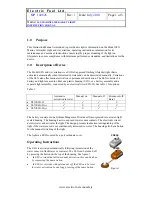
Page 35
11 HOW DOES IT WORK?
Your EPIRB contains two radio transmitters: one operating at 406 MHz which
transmits an alert which can be received by satellites, and one operating at 121.5 MHz
which transmits a signal which can be received by overflying aircraft and Search &
Rescue (SAR) homing receivers. When you activate the EPIRB, both transmitters
start broadcasting signals. Providing the EPIRB’s batteries are in good condition, the
transmission will continue for a minimum of 48 hours.
The 406 MHz alert signal can be detected by SAR satellites. American, European and
Indian authorities operate a series of satellites in low-earth and geostationary orbits to
detect and locate aviators, mariners and land-based users in distress. The satellites,
together with a world-wide network of ground stations and Mission Control Centres
(MCC) form the International COSPAS-SARSAT Program whose mission is to relay
distress signals to the international search and rescue community.
Ground stations track these satellites and process the distress signals to obtain a
location (by using Doppler location techniques*) of the distress. The processed
information is then forwarded to an MCC where it is combined with other location and
registration information and passed to a Rescue Coordination Centre (RCC) which
alerts the appropriate SAR authorities. Successive satellite passes refine and confirm
this information. Alternatively, beacons such as Smartfind Plus can use the GPS
system to obtain a very accurate position. This position is then transmitted as part of
the distress signal.
* For an explanation, visit the webpage:
http://www.cospas-sarsat.org/DescriptionOverview/doppler.htm
The network of orbiting satellites can detect signals over the entire surface of the
earth; in addition, there are four geostationary satellites that appear fixed in position
and which detect signals over enormous areas (approximately one-third of the surface
of the earth, but excluding Polar regions). However, the geostationary satellites,
because they are fixed with respect to the earth, cannot determine the position of the
EPIRB using Doppler.
The Smartfind Plus EPIRB contains a GPS receiver which can determine its own
position. This position is then transmitted as part of the distress signal. GPS reception
can be affected by several factors, and GPS systems do require a clear view of the
sky in order to work effectively, because the receiver needs signals from several
satellites to calculate its position. If the GPS cannot determine its position, it “fails
safe”; it does not transmit an inaccurate position, but instead sends information to
indicate that no position is available. Position information is then dependent on the
orbiting satellite system.
Once it has been activated for a distress situation, an EPIRB should not be switched
off until the SAR agency directs this.
Содержание SMARTFIND E5
Страница 1: ...SMARTFIND E5 G5 USER MANUAL mcmurdo mcmurdo mcmurdo mcmurdo ...
Страница 12: ...Page 7 Test button Strobe Red LED Green LED Activation switch Lanyard Sea switch Antenna ...
Страница 23: ...Page 18 Align slot with lug Locate end of antenna in slot Fit R clip ...
Страница 25: ...Page 20 Cover correctly fitted to base ...
Страница 42: ...Page 37 12 1 Declarations of Conformity ...
Страница 43: ...Page 38 ...
Страница 44: ...Page 39 ...
Страница 45: ...Page 40 ...
Страница 52: ...82 810 001 Issue 4 ...




























